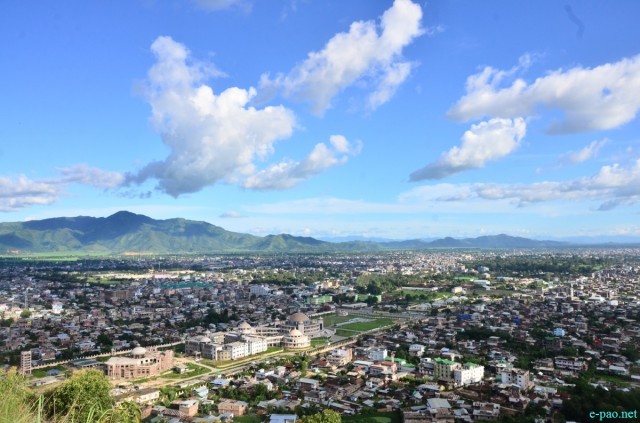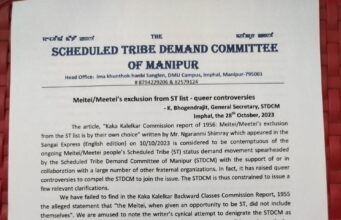By Ningombam Bupenda Meitei
Since the beginning of an exchange of trade and ideas of humans in ancient China, ancient Manipur and South East Asian region, Imphal has been the centre of meeting of people, ideas, cultures, religions and philosophies. The ancient Chinese silk route also passed through Imphal, and Manipur till today has the imprint of Greek route going towards Greek civilization. Ptolemy, the famous Greek astronomer, mathematician and geographer knew about Manipur and recorded it as “Mareura” in the 2nd century A.D. Manipur, with its first evidence of Pleistocene man in 30,000 B.C, a period of Old Stonge Age, was known in different names – such as, “Cassay” by the Shans or the Pongs who are spread in today’s Burma, Northern Thailand, Yunnan province of China and Laos; “Kathe” by the Burmese, and “Mecklee” or “Meckley” by the Assamese – by the civilizations around it. In signing the first treaty of 1762 between the British East India Company and the then Maharaja of Manipur Maharaja Bhagyachandra, who developed Manipuri classical dance – Ras Lila of Radha and Krishna, the treaty recognized Manipur as “Meckley.”
The concept of “Look East Policy” which later gets evolved into “Act East”, by the present Prime Minister Narendra Modi, is a post – India’s independence, New Delhi’s effort of “re-engaging” – not necessarily a “new engagement”, considering the historic trade exchange of ancient civilizations with Imphal or the ancient royal capital called Kangla – the potentials of trade and commerce of Imphal with the rest of South East Asian economy, but much before India became independent in 1947, already many Tamils from Tamil Nadu had started drifting to Moreh, the international border town of Manipur bordering with Myanmar, to proactively participate in trading activities with the Burmese, and today, in Moreh, Tamil Sangam, with a considerable population of Tamils, or rather Manipuri Tamils, exists with their Tamil culture being heavily influenced by Manipuri culture and foods. In fact, the legendary dancer of India’s film industry, Helen, came to India from Burma by passing through Imphal. Thousands of years before the Europe’s Renaissance and Industrial Revolution, the concept of trade already existed vibrantly in Imphal, but such deep and vast trading and commercial might of Imphal has been kept under the control of New Delhi’s policies once Manipur was recorded as a part of India in 1949. Today, in the first week of this month, April, of 2016, Manipur initiated its first Industrial Expo, from 4th to 10th April, and North East – ASEAN Business Summit, from 7th to 9th April, in Imphal, thereby making a fresh and new attempt to re-ignite the hidden fires of ancient trade and commerce, which has been in place for thousands of years in the past including British Manipur period, of the people of Manipur along with its neighbouring countries of South East Asia.
Manipur, with its Chief Secretary – Oinam Nabakishore – who is the first Meitei to hold the post in the state and who is also considered to be the brain behind bringing back Manipur to a trading and commercial linking point between the South Asian economy and the South East Asian economy, along with the support of the Government of Manipur and the Government of India and the embassies/high commissions of foreign countries, has begun to launch the North East – ASEAN Business Summit in Imphal. The North East – ASEAN Business Summit went parallel with the 1st Manipur Industrial Expo to stress on their themes – Make in Manipur and North East for Employment Generation. The 1st Manipur Industrial Expo, 2016, deliberated on textiles, handlooms, handicrafts of silk products, bamboo based products, entrepreneurs and skill fair (Kaushal Mela). The North East – ASEAN Business Summit, which was made successful with the cooperation of the state government of Manipur and Union Ministries of DONER and External Affairs, Union Ministries of Commerce and Industry, Power, Food Processing Industries and MSME, in particular, and Government of India, in general, and the officials from 8 North Eastern states and each of the 10 members of ASEAN countries (Myanmar, Vietnam, Cambodia, Philippines, Singapore, Thailand, Malaysia, Indonesia, Lao PDR, Brunei Darussalam), stressed on – attracting investment and entrepreneurship in North East India; development through connectivity in NE-ASEAN for trade & commerce and tourism; energy and mining potential in the North East India; agro and food processing; ASEAN perspective on services exports; promotion of art and culture of the North East; Ease of doing business in the North East; sericulture and cocoon industry; aromatic and medicinal plantations, and laying the foundation stones of industrial estates and MSME Technological centre in Manipur. The representatives from Thailand, Egypt, South Africa, Bangladesh and Myanmar and traders from 15 Indian states were to present their products in the Manipur Industrial Expo. Bangladesh’s Commerce Minister, Tofail Ahmed, who came with 18 members trade delegation led by the President of FBCCI (The Federation of Bangladesh Chambers of Commerce and Industry), expressed the need to sign a memorandum of understanding with Manipur Chamber of Commerce so that imports of fish from Bangladesh by Manipur and other trades between Bangladesh and Manipur can take place. Along with the Department of Commerce and Industries of Manipur, Indian Chamber of Commerce and the Institute of Company Secretaries of India organised the NE – ASEAN Business Summit.
The economic significance of having such an international business summit is also not only to make Manipur and the North East India grow economically faster and steadier but also helps in ensuring the stability and maturity of the economies of the 10 member countries of ASEAN. The economic agenda of the summit, though primarily focuses on Manipur and the North East India, as of today, could also be a part of exercising an economic diplomacy between New Delhi and other South East Asian countries, so that more interdependence of economies between India and ASEAN becomes practically meaningful and such economic integration and trade cooperation will also help in making the Asian markets, including East Asian economies, competitive and open to many global players, instead of a few traditional economic giants. Manipur is a traditional friend of Japan since the 2nd world war, and the Japanese, whether the people or the national government, have been kind enough to express their desire to fund many projects worth billions dollars in Manipur. Manipur, though not connected in terms of rail connectivity to its capital Imphal with the rest of India, has an international airport in Imphal and the airport has the potential to be a connecting air link between India and the major cities of the South East Asian countries. Flying to Singapore or Hanoi or Hong Kong or Kaula Lampur from Imphal will be more shorter in distance and time saving, along with being cost effective, rather than taking a flight from Kolkata or Mumbai or Chennai. In fact, Imphal – Beijing, Imphal – Tokyo, Imphal – Seoul, Imphal – Washington, Imphal – Sans Francisco, Imphal – Los Angeles flights will be much shorter and less in time than going to such world cities from New Delhi or Mumbai. If such dream ever happens and becomes real in this century, then Imphal will easily surpass Dubai’s economy within a decade. Such will be the existential reality of Imphal’s global economic boom, if not in the 21st century, but certainly in the early 22nd century. By then, the issues of national security and international trade embargo, like from today’s WTO, would become a moment of historical past in an archive, and a new presentation of WEF (World Economic Forum) could be a strong possibility.
Imphal has to grow, as history repeats itself and so shall economic history, and its growth has to not only cater to the needs of the local population of the state of Manipur but also to the requirements of mankind of Asia and the world as the economy of Imphal would be a major Asian economic player in a near future. It is in such a scenario that a local question – who, whether the locals or the foreign investors, will control the trade and economy emanating from Imphal and who will have a final say in Imphal’s economy? – is not merely going to remain local but also has a far deep and heavily weighing political implications, not only in the state’s politics or national politics but also in the political engagements of the countries bordering Manipur and those which are going to be influenced directly by the dynamic Imphal’s economic powers. It is at such juncture that a discussion on whether Imphal is for Manipur or India or South East Asia or Asia will become crucial and the lingering fear of the common populace of today’s Imphal could be whether “that Imphal” would still remember them, who now reside happily, with Mother Nature, in “today’s Imphal” of Manipur. Whether Imphal goes global, the indigenous population of Manipur must be the owner of the Manipur as they are bestowed as the true children of Mother Manipur for thousands of centuries of years since B.C (Before Christ).
Ningombam Bupenda Meitei is a poet, author and orator.













Please keep uploading such good article .its often difficult to find such.
Please keep upload such nice article@manipur times .
Its very difficults to find such .
Imphal valley where lies in 110km frm Burma border town Moreh was invaded by British once n annexed by India till now d reason is nothing just a point of re enforcement of everything vehicles people’s or animals at those days still now traveling through dis route say a kind of hub transit point connecting east Asia comparing to other states like Mizoram champhai dist bodering Burma n Nagaland is also bodering Burma not so suitable as Imphal tamu AH1 so it’s time 4 us to wake up n du some precaution regarding bussiness,transport,n to make a suitable update tourist spot like others du so dat we can boost our economy may b to best of our ability rather Dan our capitalist citizen investing on government contracts real states or banking system wat we call sendoichabi. New innovation ideas regarding wat I mention above is needed for a bright tomorrow’s future.
This is a rich article with a very positive Vista of Manipur of tomorrow. I hope the article is read by every Manipuri. We need more elixir articles like this to cure Manipur of its cynicism and morbidity.
Imphal is the meeting point of two cultures. The culture of east and west are meeting here since time immemorial and will remain the same. It is the cradle of two cultures from where a third culture born and the genesis of modern men have been grown in the conventional style called modernism but the sad part is that our intellect use to owe every development in Manipur to the west and brown skin culture.